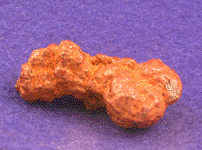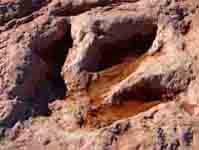Fossils-Impressions from the Past
Fossils for Kids

http://www.abc.net.au/beasts/playground/fossils.htm
Fossil Game
Types
Type I includes:
- bones
- teeth
- skin impressions
- hair
- the hardened shell of an ancient invertebrate (an animal without a backbone) like a trilobite or an ammonite, or the
- impression of an animal or plant, even if the actual parts are missing.
Type II- Something that was made by the animal while it was living that has hardened into stone. These are called trace fossils.
Type II includes:
- footprints or animal poop
 |
 |
| Coprolite |
Dinosaur footprint |
Type I fossils can be the actual thing that it once was, like a piece of bone or hair or feather. More often the bone material is replaced by different minerals contained in the liquid of the sediments that buried it. What was once bone is now some sort of crystal.
This process also takes place with shells, exoskeletons and wood. If the spaces in the bone are filled with liquid minerals which later harden it is called permineralization.
- burrows
- coprolite

What are fossils?
http://pubs.usgs.gov/gip/fossils/fossils-rocks.html
http://www.fossils-facts-and-finds.com/what_is_a_fossil.html
http://www.rockhoundkids.com/
How are fossils made?-oh the pressure they are under !!!!!
http://www.discoveringfossils.co.uk/ this site also has cool pictures
http://www.fossils-facts-and-finds.com/how_are_fossils_formed.html How fossils are formed
Download a free printable version of The Trilobites
http://www.kidskonnect.com/content/view/79/27/
The "X Marks the Spot" Where do we find them -descriptions and locations of places all across the United States you can go to collect fossils,
http://www.sdnhm.org/kids/fossils/
http://www.pbs.org/wgbh/nova/trex/dig/
Fossils in your own back yard: Michigan
http://www.dayooper.com/MichiganFossils.htm
http://www.deq.state.mi.us/documents/deq-ogs-gimdl-MFPFITB.Pdf cool with pictures
http://webs.cmich.edu/resgi/links.asp?mc=Earth%20Science&cad=Historical%20Geology&to=232&tod=Fossils
The Fossil Hunter This is a great site with great fossil collecting location throughout the U.S. I have had
very good hunting at some of the locations from this site.Virtual Field Trips This site gives very detailed descriptions of some incredible fossil sites. However the
author seems to have removed the exact directions to the locations. Usually if you can get to a nearby
town a local can at least get you pretty close.Fossils in the Bay AreaThese are some nice relatively easy places to collect along the coast of Northern
California.
Collecting Fossils in California This site list exact directions to several different fossil sites in California.
How can you tell what animal or plant the fossil is from?
Whenyou first find a fossil it is sometimes hard to tell what kind of animal it belonged to. It is
usually just a part of the original animal .
http://www.fossilsforkids.com/Now_and_Then.html
Fun facts to Know and Tell about Fossils
http://www.fossils-facts-and-finds.com/facts_on_fossils.html
I found this cool idea where you can make your own fossil-crack it open and show everyone what's inside. You could use a shell or a chicken bone
Demonstrate how a Fossil is Made:

Ingredients:
- 1 cup clean sand
- 1/2 cup cornstarch
- 1/2 tsp. alum (find in spice section of your grocery store)
- 1/2 cup water
Directions:
- Pour the sand into an old cooking pot.
- Add cornstarch, water and alum. Stir.
- Set the concoction on the stove over medium heat and stir. As it gets warm it begins to liquefy. In 2-3 minutes it will get thicker.
- As the goop stiffens and clumps like stiff cookie dough, remove from the heat and keep stirring for a few more seconds as it cools down.
- Plop it onto a cutting board or tough surface, spread it slightly for further cooling. When comfortable to touch start forming it into a ball and put a shell or chicken bone inside.
- To make a "fossil:"
Form a ball of sand goop (the size of a tennis ball) around a shell or chicken bone. Let dry for a few days until the ball is hard. Then, tap the ball with a hammer. It will crack open to reveal the surprise!
- How cool is that?????
Fossil Pictures:
http://www.fossilmuseum.net/Education.htm
http://www.geo-tools.com/fossils.htm
http://www.mineraltown.com/mineral_gallery/fossil_picture.htm
Comments (0)
You don't have permission to comment on this page.